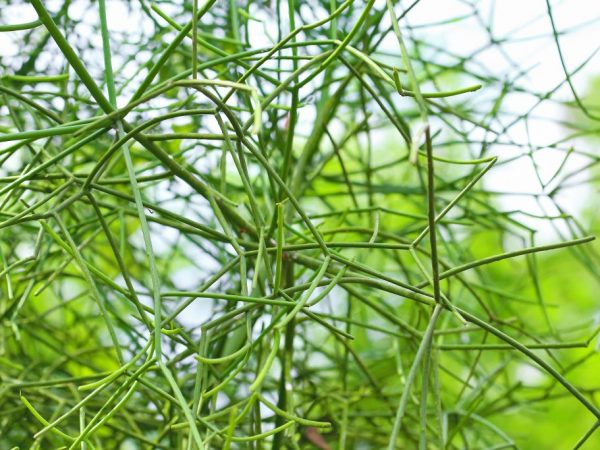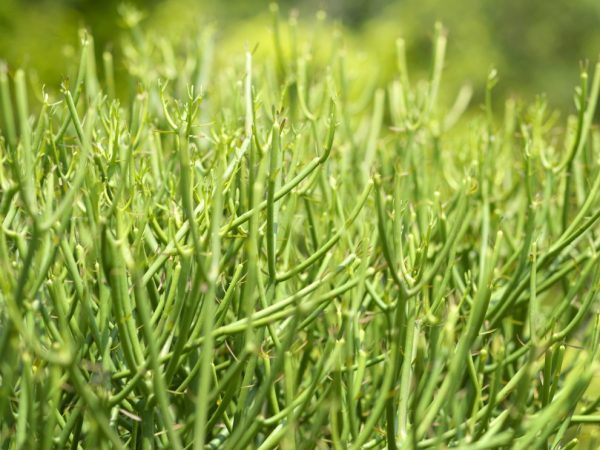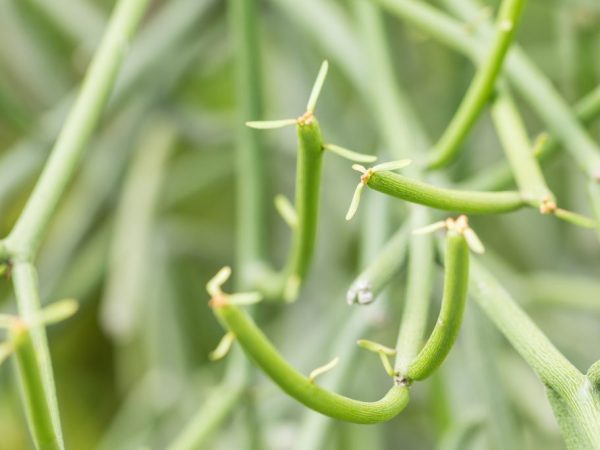Euphorbia Tirucalli is an unpretentious plant
Euphorbia tirucalli is a succulent evergreen perennial that has become widespread due to its unpretentiousness to growing conditions. The birthplace of the plant is Africa and Madagascar. In the 19th century, it was brought to other territories as food for cattle.

Euphorbia Tirucalli is an unpretentious plant
Description of the plant
The second name - rubber spurge - is given in connection with the properties of milky juice, from which rubber was previously extracted.
Attempts to use the flower as a raw material for oil production have been noted. In the 20th century, Brazilian chemist Melvin Calvin hypothesized that up to 50 barrels of black gold could be obtained from every acre of cultivated land.
Branched succulent, in natural conditions reaches 9 m. In domesticated form does not exceed 1 m. If you do not carry out a timely haircut, it is quite capable of catching up with its wild relatives in size.
Popularly referred to as the pencil cactus due to its unusual shape. Visually, the spurge resembles a coral polyp.
Leaves are present only on young specimens, they are linear, up to 12 cm in length and 1.5 mm in diameter. In the course of development, they systematically fall off in the off-season, remain exclusively at the tops of the processes. They do not participate in photosynthesis.
The role of the carbon dioxide processor is played by the stem, which has a smooth texture and a rounded shape.
A young plant with a rich green color, acquires a dark gray tint with age.
At home, Euphorbia does not form buds, in its natural environment it blooms with small yellow flowers.
During the selection, several varieties were bred, some of which are characterized by the ability to change color to brown or reddish.
The most common:
- Cypress;
- Multi-flowered;
- Mile;
- Pallas.
Purchase and adaptation
After purchasing this variety, Euphorbia is quarantined for 10 days. After that, the culture is transplanted into a new pot, which is larger than the shipping one.
Landing principle:
- Carefully removed from the old pot. Slightly shake off the roots from the substrate.
- At the bottom of the pots, a drainage layer is distributed, on top - prepared soil by ⅔ of the total volume.
- Set a succulent, sprinkle with earth.
- Watering.
The necessary conditions
It is not difficult to recreate a favorable growth microclimate for euphorbia and to provide it with proper care at home - it feels quite comfortable even in poor soils and has been actively developing for many years.
Humidity
The plant tolerates the dry climate of apartments well, and therefore does not require maintaining the level of humidity. It is necessary to spray rarely, for sanitary purposes.
Temperature

The flower does not like drafts
The optimum temperature during the growing season is 20-25 degrees. Also, in the summer, it is allowed to take out the succulent to fresh air, protecting it from the effects of drafts and rain.
During the winter months, the pot is transferred to a cool place with a constant temperature of 15-17 degrees. If the scale is lowered to 12 degrees, the flower may die.
Lighting
Despite the ability to adapt to any conditions, Tirucalli prefers to grow in a well-lit area. In the shade, the stems of the plant are painted in a deep green color; when placed in the sun, they acquire a yellowish tint.
Seat selection
The optimal location for the succulent is the southern windowsill, on which the plant will receive enough light. If the culture is deficient in sunlight, it is significantly stretched, as a result, it loses its decorative qualities.
The milky juice of Euphorbia is poisonous - it is better to place the plant away from small children.
Soil selection
The most favorable for the development of milkweed soil should include in equal proportions:
- river sand;
- leafy ground;
- garden soil;
- wood ash.
Feels good in soil with neutral acidity, however, a substrate with a Ph value of 5.0-6.0 units is considered ideal. Planting in a purchased soil mixture for cacti and succulents is also allowed.
Additionally, it is necessary to lay a drainage layer of crushed brick or gravel on the bottom of the container to drain excess moisture - the flower is extremely sensitive to waterlogging.
Care
Fertilizers and feeding
Fertilize Euphorbia only during the growing season. As a top dressing, specialized preparations for cacti are used. During the resting stage, additional nutrients are not required.
Watering
The culture is one of the drought-resistant ones, and therefore the overflow of the substrate is destructive. In the summer, the flower is watered no more than once a week; during the dormant period, soil moisture is minimized, waiting for the earthen coma to dry completely. On average, an interval of 1 month is maintained between procedures in the hibernation phase.
Water for irrigation is used standing for 5-7 days.
Pot selection

Choose a sustainable pot for your plant
The root system is located superficially, with which the requirements for pots are related. Ideally, it should be wide and low in height. Also a prerequisite for the container is the drainage holes from the bottom. For adult specimens, container stability is important.
Transfer
The first procedure is carried out 10 days after purchase. In this case, the pot should be chosen with a larger shipping one.
Subsequently, they are transplanted every 2-3 years as the container is filled with roots.
Pruning
Due to the rapid build-up of green mass by Euphorbia, it is necessary to carry out regular formative pruning. The procedure is planned for the spring. A well-sharpened knife is used as a toolkit, with which the upper part of the shoots is cut to the desired length. After the place of cuts, it is recommended to treat with crushed activated carbon.
All manipulations are carried out in protective gloves to avoid irritation of the skin and mucous membranes with milky juice.
Reproduction
Reproduction of euphorbia at home is carried out only by cuttings. In rare cases, the process occurs naturally, when the stem of the plant lengthens and, having reached the surface of the soil, takes root. A similar phenomenon occurs in the natural area.
Reproduction principle of succulent:
- With a sharp knife / scissors, cut off the apical shoots. After the cut point, the processes are placed in a liquid in order to eliminate the milky juice.
- Dry the cuttings during the day. Additionally, the wounds are treated with phytohormones or crushed activated carbon.
- A layer of peat soil is laid out in a pot, on top of coarse sand, which is thoroughly washed in running water beforehand.
- The stalk is installed in the substrate so that it is submerged in the cut into the lower layer of the earthen cushion.
- Watered, covered with a jar or polyethylene. They are placed in a warm, well-lit place.For the splendor of the plant, it is allowed to place several cuttings in one container at once.
Diseases and pests
The emergence of harmful insects and ailments are the result of improper care and improperly created microclimate. With full adherence to the requirements of culture, such situations do not arise.
Table 1. Pests.
| Insect name | Symptoms, description | Treatment |
| Aphid | Small green insects. Form numerous colonies feeding on plant sap. In the process of vital activity of parasites, the affected areas turn yellow and curl. | In case of minor damage, it is enough to treat the surface with soapy water. In a critical situation, the culture is placed under a warm shower, trying not to injure fragile segments. After sprayed with systemic drugs (Aktara, Fitoverm) |
| Spider mite | The size does not exceed 0.6 mm. The color ranges from yellow to brown. It is determined by a thin white cobweb. Appears due to low room humidity. | They are treated with saturated soapy water and insecticides. |
| Mealybug | It is a white parasite. In most cases, it affects the root system, extremely rarely settles on the aerial part of the plant. | The succulent is transplanted into a new soil and a pot, and the affected areas are pre-docked. They are treated several times with chemicals with an interval between procedures of 7-10 days. Additionally, it is recommended to remove cotton-like insect marks with a cotton swab dipped in alcohol. |
Table 2. Diseases.
| Problem | Cause | Treatment |
| The stems have acquired a brown tint | May be a natural occurrence in the cultivation of certain varieties of the variety, which manifests itself under the influence of sunlight. If the color change is accompanied by a loss of turgor, the reason lies in hypothermia. | It is not possible to save the plant. The minimum chance is to recover by the succulent itself at the expense of internal reserves. |
| Root rot | Overmoistening or lack of a drainage layer in the pot | The injured segments are cut off, transplanted into a new soil. If the room is characterized by low temperatures - rearranged to a warmer place |
| Yellowing of leaves | Excessive lighting | Euphorbia is shaded. |

